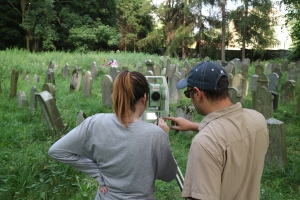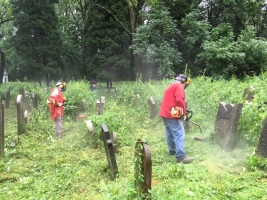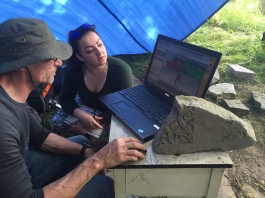Historical Research
Detailed historical research will be undertaken on the nature of cultural and physical genocide within Jewish cemeteries.
Documents, photographs, aerial imagery, maps, plans, witness testimony and data gained during site visits will be collated and analysed in order to examine the reasons why Jewish cemeteries were desecrated and used as killing sites and why certain cemeteries were targeted.


Mapping and Visualisation
Using a unique non-invasive approach, we will seek to locate unmarked killing sites, graves and matzevah (tombstones), and to record the evidence of cultural genocide at our selected sites. In doing so, we will forensically document Holocaust sites whilst accounting for their religious and commemorative significance because our approach will not disturb the ground (Sturdy Colls 2015). Therefore, our methodology is specifically designed to account for Halacha Law with regards to the treatment of Jewish burials.
This approach will use:
- A purpose-built mobile application – to record matzevah that remain within the cemeteries or which are found outside their walls
- Photogrammetry, including 360-degree photography, photo-realistic capture and drone-survey – to record the cemeteries, specific traces within them and their wider environment
- Terrestrial LiDAR (laser scanning) – to record individual matzevah (tombstones) and evidence of cultural genocide in 3D
- Topographic survey, including GPS and Total Station technology – to map fences, matzevah, graves and other landscape features
- Geophysical survey, including Ground Penetrating Radar (GPR), to identify below-ground traces such as unmarked graves, toppled tombstones and buried structures
This approach will offer the opportunity to identify, characterise and preserve material remains that lie both above and below the ground within our selected cemeteries. It will also provide visualisations for use in our educational outputs.


Restoration and Reconciliation
As well as recording the evidence of cultural and physical genocide, our project aims to carry out restoration works within selected cemeteries and to engage people from a diverse range of backgrounds in our activities.
Working with our partners, tombstones will be reinstated, graffiti removed and cemeteries tidied. By undertaking this work, the project intends to explore the benefits of community archaeology and restoration as means to tackle intolerance.
In our project, we use the word reconciliation in the sense of bringing people together. Community volunteers, young people, educators, policymakers and a wide range of other groups from all over the world will come together to explore past and present examples of the destruction of cultural spaces, allowing reflection on the causes and consequences of these attitudes and actions.


Digital Approaches to Dissemination
The project’s results will feed into a state-of-the-art digital platform – a novel educational tool which can be used by a wide range of people all over the world to raise awareness of the Holocaust and xenophobia beyond the lifetime of the project.
Archaeological survey and mapping data will be presented alongside the results of the historical research in order to present the diverse range of evidence connected to cultural and physical genocide within selected cemeteries.
The platform will also provide a tool for researchers and educators with an interest in the Holocaust and pre-war Jewish life.
This platform will be developed with the ethical issues involved in the visualisation of Holocaust-related information in mind, drawing upon Staffordshire University’s ongoing research in this area.
